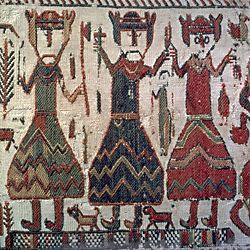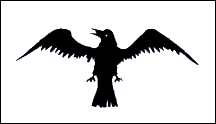From Pagan to Christian:
The Story in the 13th-Century Tapestry of the Skog Church,
Hälsingland, Sweden
by Terje Leiren
University of Washington, Seattle
The Skog Church Tapestry
This woolen tapestry on a white linen background is believed to date from the
late 13th Century, after Sweden's conversion to Christianity.
The tapestry, originally from the Skog Church in Hälsingland, Sweden,
has been in Stockholm's Museum of National Antiquities (Statens Historiska Museum)
since 1914. It is more than just a tapestry, it tells a story of a culture in
transition.

The tapestry contains a stave church in the center with a congregation
inside the church. On the eaves of the church roof are two dragon heads.
There is a bell tower in the church and another next to the church itself.
Animals, believed to be lions, are approaching the church from the left,
while horses, and soldiers/knights, approach from the right.
Traditionally, this has been seen as the church under attack. To the far
left of the tapestry are three figures, usually thought to be Scandinavian
kings/saints Olaf, Knud, and Erik. In fact, these are not only Christian
saints.
The Viking Trinity
According to Adam of Bremen: "If plague and famine threatens, a libation
is poured
to the idol Thor; if war, to Odin; if marriages are to be celebrated, to
Frey."
Because Odin, the All-Father, was generally more feared than loved and
subsequently kept at a distance, his son, Thor, assumed the position as
favored
deity. He was the protector and trusted friend. Some myths associated
with
Thor had him as almost human, with his foibles and gullibility. His
hammer came
to be used as an amulet, not only to signify the wearers allegiance to the
old
faith, but also as protection against the evils abounding. Odin
and
Thor were the most prominent members of the militaristic Æsir
family. Frey, god of fertility and fecundity, led the Vanir family, the
early
opponents of the Æsir. However, a truce between them brought Frey to
Valhalla and elevated his status to be one of the Norse trinity.
With the
conversion to Christianity, the Norse trinity, although driven
underground by the Christian church, nevertheless, remained significantly
conspicuous, albeit in changed form. Scandinavian/Viking kings could
easily be depicted as representions of the earlier pagan deities without
the authorities of
the Roman Church being any the wiser. In the same way that an anonymous
woodcarver craftsman working on the Borgund Stave Church in western
Norway could put a representation of the one-eyed Odin on the top of a
column in the dark upper reaches of the sanctuary, so too could an
artisan represent the pagan gods as medieval kings and/or saints.
Consequently, with his axe, St. Olaf came to be associated with Thor and
his hammer. In the tapestry, however, there seems to be a mixing of
deities, as St. Olaf with his axe represents not Thor, but the one-eyed
Odin who is placed next to a representation of a tree, perhaps the
Yggdrasil from which he had hung. In addition, King Knud, killed at the
alter of St. Albans Priory in Odense, Denmark, is placed in the middle,
holding a Thor-like hammer(the crucifix?), while King Erik ( the fertility
diety, Frey) flanks him on his right holding an ear of corn. This
arrangement, with Thor in the middle, is similar to Adam of Bremen's
description of the idols in the great temple at Uppsala where Thor is said
to be flanked by Odin and Frey.

The Bells
It was generally believed by medieval Scandinavians that bells cleansed the air,
purging it of evil spirits. According to Rimbert in his Life of St.
Ansgar, church bells were considered unlawful by pagans. Perhaps they
frightened the spirits. Christians, of course, had no such qualms, indeed they
probably sought to intimidate those very same spirits protected and
nurtered by the pagans. Bells, of course, called the Christian faithful to
worship, but there was a far stronger symbolism at work. When Gustav
Vasa, during the Lutheran Reformation, around 1527, began confiscating
church bells for metal to help restore the state treasury, it aroused such
indignation among the citizenry that his royal authority itself was
threatened and pretenders to the throne began calling for his
overthrow.
Dragons and Other Animals
Just as bells frightened spirits and cleansed the air around a Christian
church, dragon heads were placed on the roofs of stave churches to
frighten away evil spirits. Although today, animal heads on the stave
churches give it a quaint appearance, their use in the architectural
structure in the 12th and 13th
centuries was, however, very serious business. In old Icelandic law, it
was
illegal to bring a ship, with its dragon-head bow, directly into land for fear of
offending the spirits of the land. Christian converts did not give up their
traditional beliefs in pagan spirits, but instead of protecting and placating
the spirits, it was the church and the worshippers inside which now had to
be
protected. Dragon heads, therefore, served a useful purpose as a part of
the church structure. Dragon heads on the church in the Skog Tapestry
face out as a protective force for the Christian faith, the faithful and
the physical structure of the church itself.
The dragon is only one of a number of animals (real and mythical) in the
Viking religious universe. While the dragon is attacking the roots of the
Yggdrasil (the World Tree), a squirrel runs up and down carrying insults
between the dragon and the eagle in the canopy of the tree. Most
prominently, of course, the Fenris Wolf and the World Snake are two of the
representations of evil and chaos itself in the Norse world view. All
animals were not evil or threatening. In Christian Scandinavia, the lion,
an animal not found in Scandinavia, represents power and royal prestige.
In the pagan world, Odin is also associated with animals --his
magical horse, Sleipnir, and his two ravens (Hugin and Munin) who served as his
"eyes and ears to the world," bringing him news of all developments.

Conclusions
The transition from Paganism to Christianity in Scandinavia was not an
easy one
for Scandinavians to make. The Swedish writer, Vilhelm Moberg, called it the
"300-year War." From the time of the appearance of the first Christian
missionaries in the early 9th century until the final conversions in the
11th and 12 centuries, Pagan Scandinavia was under constant pressure from
the forces of the "White Christ."
When leaders converted, pressure on the people was increased, of course.
Olaf Trygvasson's forced conversions in Norway, as well as Charlemagne's
two hundred years before him in Saxony, were no less brutal than any pagan
Viking raid. The transition between paganism and Christianity, however
brutal and uncertain it might have been, nevertheless, saw a merging of
cultures and beliefs. The art and the architecture of the time certainly
demonstrate this. We see it reflected in various elements of stave church
construction and also in such things as the Skog Tapestry.
What, then, of the numerous gods and spirits? Many survived by
going underground and are found in Scandinavian folklore and popular
belief.
Trolls are not unlike the giants of Jotunheimen who constantly battled the gods
allied against them. In some instances, trolls are just as dim-witted as
the giants themselves appear to have been. The principle deities,
however, were too easily recognized by the authorities in the Church, and
were, therefore, forced to take deeper cover. If you look carefully,
however, you can occasionally find them in medieval iconography, often
disguised as kings or saints. What better way to keep Thor and Odin alive
and out of the clutches of the Christian authorities than to dress them up
to look like medieval Christian saints?
Terje Leiren
Department of Scandinavian Studies
University of Washington
Copyright © 1999-2019, Department of Scandinavian Studies, University of Washington, Seattle, WA
98195-3420



